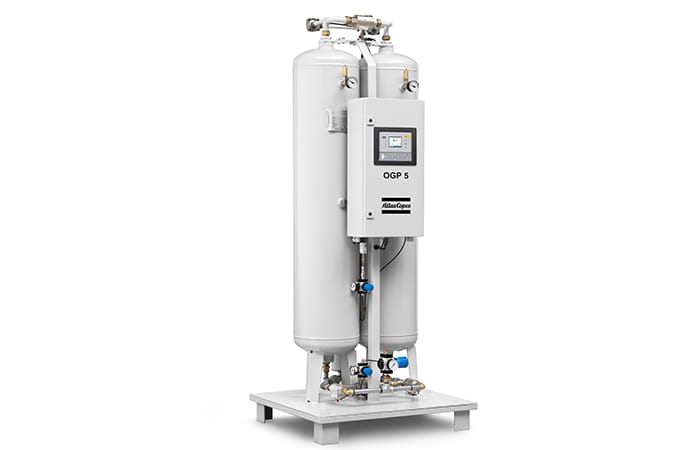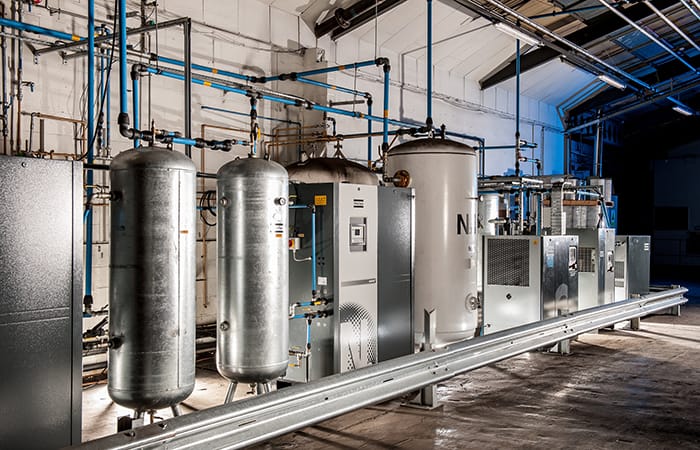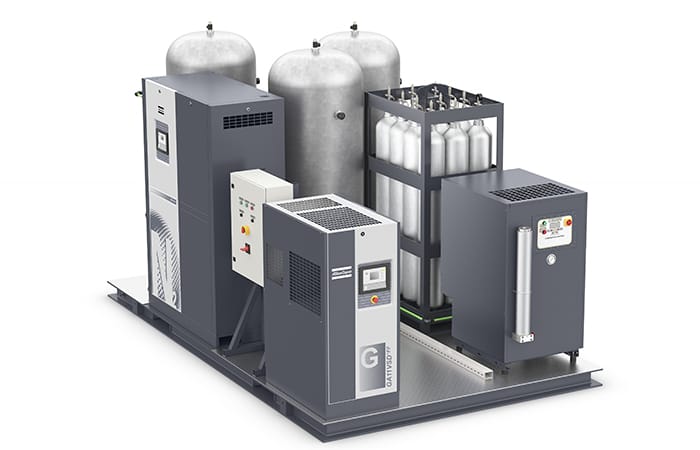
UK industry needs dependable supplies of industrial gases such as nitrogen and oxygen for a wide range of its processes. Many large users are now taking advantage of new gas-generation technology to produce gases on site instead of relying on external suppliers. This has boosted their productivity, cut their energy use and saved them money.
Why the change in approach? Many operations managers are now making a trade-off between the cost and convenience of on-site gas generation and the drawbacks of using bottled or bulk gases, including the carbon emissions associated with delivery, wastage from on-site storage, equipment rental fees, and safety concerns during handling.

Nitrogen – uses and delivery
Let’s take nitrogen as an example. Nitrogen is usually extracted by cooling air to –196o C, the temperature at which it liquefies and can be separated from the other gases. This process takes a lot of energy. Suppliers deliver nitrogen in liquid form, and then it has to be stored in a cooled tank on site. Up to 3% by volume of the stored nitrogen can be lost each day through venting. If the gas is supplied in cylinders, up to 10% of it ends up being returned to the supplier in the ‘empty’ cylinders.
The benefits of on-site generation depend on variables such as its required purity, the logistics of local production versus delivery, and overall costs.
For example, nitrogen plays a vital role in the food and beverage sector, especially for breweries and packaging operations, where it is used to purge kegs, in bottling and to create a preservative atmosphere for packaged goods. The optimum nitrogen purity for these operations is around 99.5%, but the purity of delivered liquid nitrogen is usually 99.999%, far greater than necessary for the application and hence an unnecessary cost.
It is the same story in industry. For instance, in fibre laser cutting processes, the nitrogen often used as an assist gas is usually delivered from high-pressure cylinder packs, at an energy cost ten times that of on-site production. Both the electronics industry and the oil, gas, chemical and petrochemical sector use nitrogen for blanketing purposes, for example to prevent oxide formation in soldering operations or to stop explosive atmospheres developing in storage tanks. For these applications, purity levels of 95% – 99% are adequate, and what really matters is that process sites, especially if they are remote, have a reliable, continuous, independent supply to maintain operations.

Oxygen in biogas, water treatment and aquaculture
Oxygen gas is also widely used in industrial processes. For example, in anaerobic digestion systems for biogas production, small quantities of oxygen are added to the tanks to decrease hydrogen sulphide levels.
In water treatment plants, oxygen is converted into ozone and used in a way that allows pesticide levels to be reduced. Delivered liquid oxygen is often too pure for this application, and so it has to be mixed with compressed air, at an additional energy cost, to compensate.
A constant, reliable supply of oxygen is also important to fish farms, where it can help improve feed conversion rates, prevent hypoxia, and boost production. Delivering oxygen to these sites, which can be remotely situated, can be difficult and costly.

The cost/benefit equation
The cost of delivered liquid nitrogen ranges from 10p per m3 to 30p per m3, or from 60p to £3 per m3 for delivery in bottles. The cost of generating nitrogen on site can be as little as 2.5p per m3, and is no more than 9p per m3, depending on purity, flow and pressure requirements.
Installing a gas generation plant can seem like a challenging capital investment, but its cost needs to be compared with that of installing liquid storage facilities for delivered gases. It’s also becoming easier to get finance to install gas generation equipment.
How does gas generation work? In a typical nitrogen or oxygen production system, the dry air output by a compressor feeds a gas generator, a buffer tank, and a storage tank. The gas generator process uses a technique called pressure-swing absorption, in which a carbon molecular sieve separates nitrogen molecules from the compressed air while oxygen, carbon dioxide, water vapour and other gases are adsorbed on the sieve’s surface.
Control algorithms ensure the gas generator’s output matches the demand, at minimum energy cost. When the demand for nitrogen drops, the pressure-swing absorption process is slowed down to produce nitrogen more efficiently. This also reduces wear on valves, which reduces operating costs by increasing the service intervals. Atlas Copco’s latest NGP+ nitrogen generators also minimize the amount of compressed air they use to obtain a specific nitrogen flow, which further reduces running costs.
Industrial gases are a vital part of many industries. Producing them on site, rather than having them delivered, can make sense for businesses that want to minimise their costs and environmental impact while improving their control over their key processes.










National Gas receives funding to develop Gravitricity underground hydrogen storage system
One single rock salt mine - Winsford - has 23 <i>MILLION </i>cubic metres of void and even allowing for 10% of that void set aside for hazardous waste...